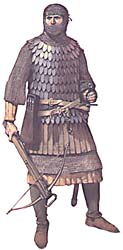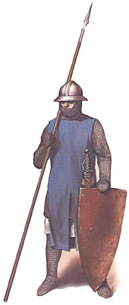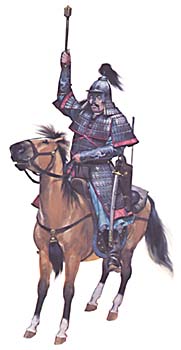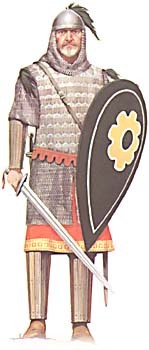
This category covers any sort of clothing sturdy enough to provide some protection against a blow.

This heavily armoured crossbowman is wearing a scale jerkin over his padded chainmail hauberk. Scale armour is so-called because it is made up of rows of overlapping scales, normally of metal but sometimes of horn or rawhide, which are laced or riveted to a canvas or leather backing. It provides good protection against slashing attacks and plunging fire (i.e., arrows or the like on a downwards trajectory) while permitting a reasonable freedom of movement. It is very vulnerable to an up-thrusting attack, however, as such an attack can easily pass between the rows of scales which are not secured along their bottom edges.
Scale armour is cheap and easily made and maintained, requiring less skill in design than the more advanced lamellar styles. It is reasonably heavy, since it relies for its efficacy on overlapping pieces of metal. Of all the metal armour types, only chainmail (or a very well designed and fitted suit of plate) allow greater freedom of movement than scale.


Chain mail is made by interlocking rings of metal into a flexible protective fabric. The methods of interlinking can vary to create mail of greater or lesser density, but the most common type is to have each ring linked with six others. The individual links are normally closed with tiny rivets, though in some very rare cases they are welded closed. In cheaper types the ends of the rings are simply butted together, and rely on the strength of the metal to prevent them spreading apart under stress. The construction of good quality chain armour requires a reasonable degree of skill in the armourer, though once the wire for the links is drawn and the rivet-holes punched, assembly is pretty straightforward. Fitting chainmail to the individual is similar in technique to fitting any suit of clothes, though allowance must be made for the fact that the chainmail "fabric" does not stretch at all.
Chain provides greater freedom of movement than any other armour type, and when worn on its own it also allows good air-flow through its links to keep the wearer cool. It provides quite good protection against cuts, but it is less effective against thrusting attacks which can spread and break the rings, and chain alone provides little protection from crushing attacks which can bruise the flesh and break bones. It is used in all sorts of configurations, on its own and to supplement other armour types. Three configurations are shown in the illustrations; on the left are two of the most common. The man on the left is wearing a simple T-shirt of chain over his tunic. His companion is wearing a more extensive hauberk which extends down to cover his thighs, and includes a camail, like a chainmail balaclava, to protect his head, neck and shoulders. The spearman in the illustration to the right wears a complete suit of chain which leaves only his upper face exposed, and beneath the mail he wears padded armour to help spread the impact of crushing attacks.



The finest armour available is exemplified by the harness worn by the knight in the centre of the picture to the right (German, c.1485). He is almost completely protected by an evenly distributed system of interlocking plates which allow excellent freedom of movement and flexibility. The individual plates are of variable thickness, allowing for the greatest degree of protection in areas of greatest vulnerability while keeping weight to a practical minimum.
His horse is similarly armoured, though the legs are left unprotected. Some horse armours — or barding, as they were known — did include leg protection, but they were not very popular as they increased weight and restricted the horse's movement far too much.
A harness of this nature is phenomenally expensive; it requires great skill in manufacture and must be fitted to the individual wearer. You can expect to pay at least 1,000 gold crowns, and possibly more, for this sort of quality. Note that this price does not include the cost of the horse or any weapons.
Considerably less expensive — and less comfortable — is the harness worn by the pikeman on the right. This so-called munition plate is "off the rack", and allows less freedom of movement than the knight's equippage. The abdomen is protected by a single plate, but the rest of the torso, hips, shoulders and upper arms are covered only by chain mail and a brigandine jerkin. Less care is taken in adjusting the thickness of different sections of the plates during construction, so they must be heavier to provide the same degree of protection as the more high-priced armours. The overall protection provided is still excellent, but the difference in quality, and freedom of movement, between this and the previous harness is quite noticeable.
Last is the mounted crossbowman to the left. He wears a plate cuirass and sallet, and a long-sleeved chain shirt. His only leg protection is provided by heavy thigh-length boots (folded down in the illustration).